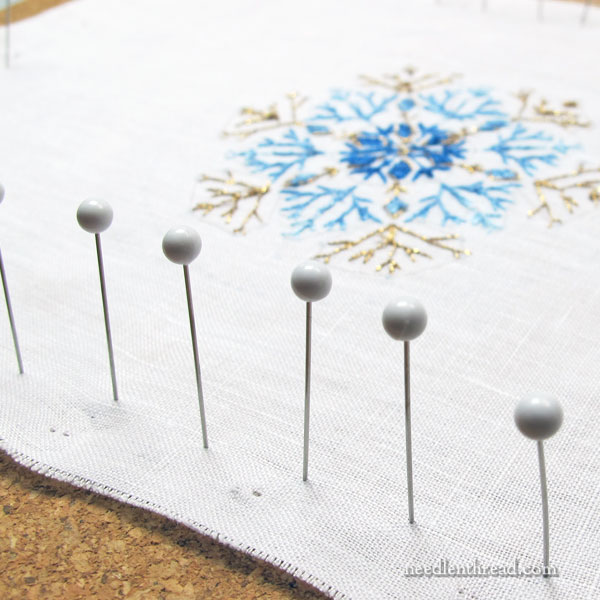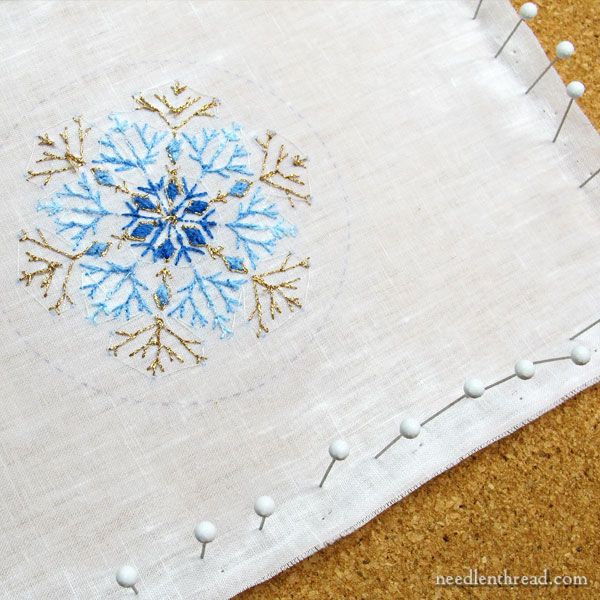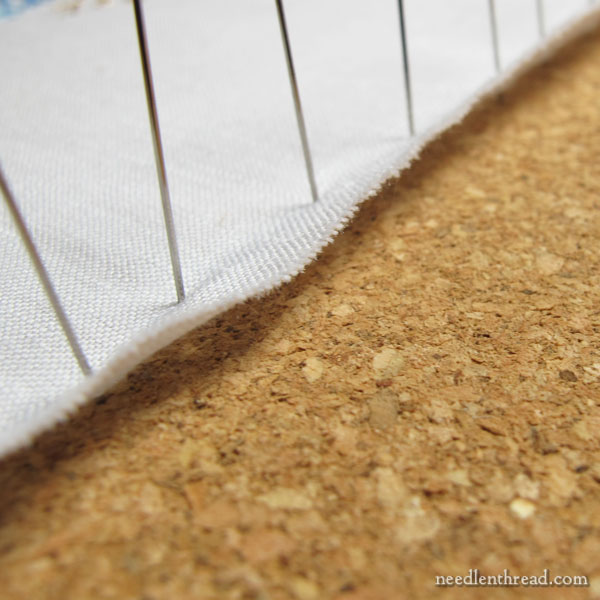Damp stretching (sometimes called blocking) is a crucial step you should never skip on embroidery that’s going to be finished into something, whether it’s framed art, an ornament, a needlebook, a pin cushion, a couch cushion, or anything else.
I’ve written about damp stretching – which I used to affectionately call damn stretching because it was often a frustrating pain for my fingers and hands! – here, with a tutorial. The tutorial will teach you the concept of damp stretching. As you progress through your embroidery journey, you will probably make little tweaks and adjustments to how you damp stretch your work.
At the beginning of this whole ornament-making process, I made some adjustments to my approach to damp stretching, and they are adjustments for the Oh-So-Much-Better. Why didn’t I do this before?!? Since there are some 20 snowflake ornaments floating around here now, I have a Massive Appreciation for these tweaks that have made damp stretching easier for me.
So I thought I’d share them with you! It’s really a matter of supplies, more than anything else…

So, damp stretching or blocking embroidery is simply pinning your embroidery project out on a piece of cork or anything that’s pin-on-able, misting it with water, and letting it dry.
When you pin the embroidery out, you make sure that the fabric is straight, pinned on the vertical and horizontal grain of the fabric. (You can read about fabric grain here, if you’re unsure of what fabric grain is.) Basically, you want to make sure your embroidery is “squared up.”
I used to pin with push pins or with thumb tacks.
And I used to pin on a large cork board from an office supply store.
Now, I pin with quilting pins with big fat heads (like the ones I wrote about the other day, here).
They are so much easier to push into the fabric and the cork. Part of that is because they are much finer than push pins and much sharper than push pins, and part of the ease is because of the cork I’m using, which I’ll explain below.

Here, my embroidery is pinned face-down on the cork board.
The cork board is clean, and it doesn’t give off any color or anything like that. But then again, I don’t wet the fabric enough to soak the cork. If you’re worried that your cork is somehow color treated, then you can always cover your cork board with a piece of fabric or even cling-on film wrap and pin through that.
Why did I pin it face down? I’m not exactly sure. I think it’s because it has beads and metallics on it, and I just thought I’d protect the front of those a little bit – no water accumulating in the beads or in the metallics. It doesn’t really matter, though!

Here, the back of the fabric has been misted all over with water.
I used to use any old spray bottle, but now I use a misting spray bottle that puts out a super fine mist. I wrote about it in this article on framing.

My Favorite Part of damp stretching is in the seconds – I really mean seconds – following the water mist. Inside the pinned area, the linen magically smooths out. It’s so delectable to see, it almost makes my mouth water! I live for that part of damp stretching.

I usually leave the embroidery on the cork for a while, while I go about doing other things. Sometimes, I leave it on there overnight.
See how the edge of the linen is pulled up outside the pins? Part of that is because of the drying and tightening-up that went on inside the pins. Even though I usually pre-shrink my linen before I stitch on it (you can read about that process here), there’s still some shrink involved when you damp stretch. Because your linen (or cotton or whatever fabric you’re using) has been in a hoop or on a frame, it’s been stretched out a little bit. Wetting it slightly and letting it dry is going to remove that stretch.

This is the real game-changer for damp stretching for me, though.
I bought a pack of four 1/2″ thick cork tiles. They’re 12″ x 12″.
The pins just slide right into the cork. They don’t run into the backing of a cheap office cork board – which is usually covered with the thinnest veneer of cork!
And I can damp stretch top-down on my table top, rather than from the side on a large cork board that’s hanging or leaning against a wall.
If the project is larger than 12″ x 12″, I can lay two tiles (or four – or more!) out on the table and pin away.
The deep cork tiles make Such a Huge Difference in the ease of damp stretching. Coupled with the quilting pins, they are a perfect solution for tabletop damp stretching that is easy, easy, easy on the hands. There’s no effort involved in pushing the pins into the cork or pulling them out – unlike with push pins or tacks on a thin cork board.
And on top of the ease of use, they are wonderfully mobile, so I can move them out of the way, or I can take them with me for demos, or what-have-you.

It turns out the cork tiles are multi-purpose, too. So far, I’ve used them for prick and pounce preparation (you can read about prick and pounce pattern transferring here) – what I’m doing with that is a conversation for another day, though!
And I’ve used them for some photo backdrops, too.
So, if you are looking for a good solution for damp stretching that is easy on the hands, efficient, comfortable to use on the table top, mobile, and that has good multi-use options, look for thick cork tiles.
They’re wonderful.
Where to Find Them
I think hobby, craft, and art shops probably carry these, but I couldn’t find the size and thickness I wanted locally. I really wanted 1/2″ thick tiles, not 1/4″ thick, which seem to be more common.
So I bought mine online – Amazon has them. I’ve added the cork tiles I purchased to my Amazon Recommendations page under the Tools and Accessories list. If you want to build a more permanent cork board with them, they are adhesive-backed, but I don’t use them that way. I like them mobile and small, with the option of being expandable, so I left the backing paper on them.
The link to my Amazon recommendations page is an affiliate link, which means that Needle ‘n Thread receives a small commission for purchases made through those links at no extra expense to you. Every little bit helps, so thanks for shopping through my recommendations page!







Hi Mary, and thanks for the helpful article on damp stretching. I am thinking that, rather than purchasing cork tiles, I might be able to use the dense, flat foam blocks that I use for some of my bobbin lace. Do you see any problem with that?
Depends on the weight of the foam. I would guess it would be ok, as long as it gives you a firm, flat, unbendable surface.
AND you can put them away when you are done and so keep them clean..
I have been using a cork board for years to do my blocking. To help make it easier to keep everything square and straight. I covered it with gingham cloth. Of course I shrink and assure that the material is color safe. The size of squares is up to you, but once it is squared on the cork it makes life a little easier!
I have something like that that has been covered with a gingham fabric (stretched on square). Then you have squares to use to align the fabric you are stretching.
Dear Mary,
thank you, you solve a number of my problems with this article! Now I know what I have to do in my Christmas holyday.
Good times to you
Ingrid
Morning Mary,
What a great idea for damp stretching your work and will definitely work beautifully for smaller pieces. I have a piece of half inch thick particle board, 18 x 24, to wet stretch my water color paper on. Had to paint it with a coat of white latex because unlike cork it will stain, wood particles and binder being of an unknown origin. The paper is sopping wet after soaking in a pristine clean bath tub when you stretch it and not misted damp as the fabric is. Haven’t tried pushing dress makers pins in it but unless you run into a wood chip I imagine it would be just as easy as the cork. I’ll let you know in a couple of months after I finish my sampler. After 40 + years of use and being propped behind the door when not in use, it’s still flat as a pancake.
Best wishes, Brenda
I really like your web page, and all the wonderful information & instructions you have here.I am getting back into smocking after 20 + years of absence. Barbara
I haven’t tried them for blocking embroidery, but for blocking my knitting, I use the interlocking foam mats sold for small children to play on. They’re great because you can make them into different sizes and shapes to fit the item you’re blocking, and they pack away nicely. They also come in different thickness from about half an inch to an inch. And they are completely colourfast.
I definitely need a new hoop! My old wooden one is not working well anymore. I have had it forever and it is just the kind you would get in a beginners kit. I mostly embroider tea towels so that is the thickness of fabric I need a hoop for. I would love some recommendations.
Hi Mary,
Love the idea of using thick cork tiles. I may give it a go sometime.
I use a small office cork board that has an OK thickness of cork on it. I’ve covered that with two overlapping A3 sheets of high quality graph paper — lined up nicely — with a piece of fairly sturdy polythene on top. For large projects I have some big interlocking foam tiles I intend to set up the same way.
Finally, I use Entymology pins. They are super fine, reasonably sturdy and long. They have a black coating which prevents any kind of tarnishing and makes them quite slippery. The only possible downside is that they have a small head, but I don’t find that a problem as you can line them up by holding the shaft and only gentle pressure is needed to push them home.
Dear Mary
Haven’t written for a long time, partly because my computer is playing up no internet this morning, and various other things that have come up leading up to Christmas. Anyway these look great and a great idea for the technique of damp stretching. I must buy some of those pins, I hope I can obtain them here in the UK. Thank you for sharing with us your advice on small cork squares for damp stretching, it’s very helpful.
Regards Anita Simmance
Hi, Anita! It’s a busy time of year, isn’t it?! Any good pins will do – they don’t have to be the same brand. Just look for similar qualities. I hope your internet and computer problems melt away. That’s always such a pain in the neck! Oh, technology! It’s supposed to make our life so much easier…
That’s a super helpful tutorial thank you, Mary! I have damp stretched my embroidery ever since reading your article from several years ago using the pushpin method, but I can imagine how much easier the glass headed pins will be to use. And I love the cork tile idea.I have saved a couple of large cork boards for this job, but storing them in between intermittently using them isn’t always easy. I will investigate the tile options, thank you for the handy tip.
Thanks Mary, you’ve done it again. I’ve bought the snowflakes but not started them yet, so your technique of using the cork boards will be wonderful. I have quilting pins so it’s full steam or should I say “mist” ahead.
Your blog page is stupendous. Thanks again, Alain Louise
Even though I had only thin cork, this worked well for a couple of embroidery pieces I did last year – really great instructions!
Now I’m a bit stuck. How do you adapt this for stumpwork and canvaswork? My needlework book says to cover a soft board in polythene and hammer pins in for needlepoint, which sounds potentially right, though I’m not sure. (It gives instructions more like yours for embroidery so I assume the difference is because canvaswork is usually heavier?)
I’m worried about the wire rusting and not getting the canvas threads damped at the back since it is too bumpy to block face down. I’m also not sure whether to attach everything while the piece is still on the frame or whether it is better to remove it from the frame and block it first. (This would reduce the wire problem, though one bit is worked directly into the canvas, so that’s not detachable. This was probably a Bad Idea as the canvas may be particularly distorted there.)
I guess I’ll end up having to muddle it through somehow as the thing is unwieldy and a bit weird in various ways ….
Wow! You can’t even blink! And, yes, the sides are starting to curl up, too. You are a wizard! Thanks. Judi R.